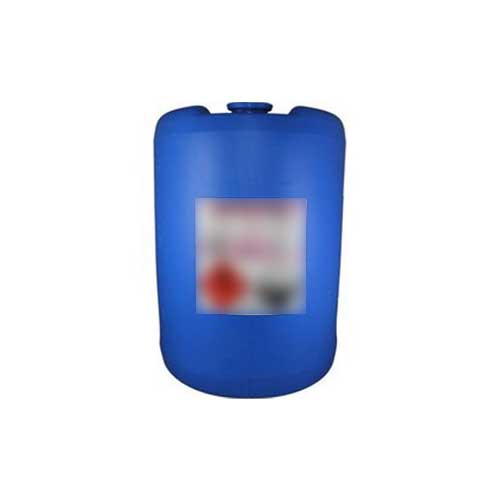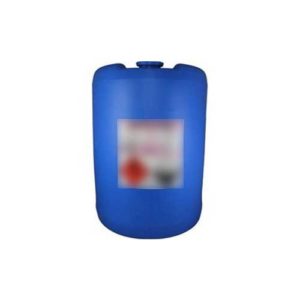NITRIC ACID-HNO3
ABOUT:
Nitric acid is typically produced by the oxidation of ammonia (NH3) in the presence of a catalyst. There are several methods for manufacturing nitric acid, but the most common process is known as the Ostwald process, which consists of the following steps:
Oxidation of ammonia: Ammonia is oxidized using a platinum-rhodium catalyst at a temperature of 850-1000°C and a pressure of 8-12 atm. The reaction produces nitric oxide (NO) and water vapor:
NH3 + O2 → NO + H2O
Oxidation of nitric oxide: Nitric oxide is further oxidized to nitrogen dioxide (NO2) in the presence of air:
2NO + O2 → 2NO2
Absorption of nitrogen dioxide: Nitrogen dioxide is absorbed into water to form nitric acid (HNO3) and nitric oxide:
3NO2 + H2O → 2HNO3 + NO
Recovery of nitrogen oxide: The nitric oxide produced in step 3 is recycled back to step 1 to oxidize more ammonia.
4NH3+ 5O2 + 4H2O → 4HNO3 + NO
PHYSICAL PROPERTIES:
Molecular weight: 63.01 g/mol
Melting point: -42°C (-44°F)
Boiling point: 83°C (181°F)
Density: 1.5 g/cm³
Vapor pressure: 8.5 mmHg (at 20°C)
Viscosity: 1.2 cP (at 20°C)
Refractive index: 1.411 (at 20°C)
CHEMICAL PROPERTIES:
- Miscible (completely soluble)
- Nitric acid is a strong acid, which means that it can donate a proton (H+) to other substances. It can react with bases, metals, and metal oxides to form salts and water.
- Nitric acid is a powerful oxidizing agent, which means that it can accept electrons from other substances. It can oxidize many metals, such as copper and iron, and can also oxidize organic compounds, causing them to decompose.
- Nitric acid can react with organic compounds to introduce nitro functional groups (NO2) into the molecule. This process is called nitration, and it is used to synthesize a variety of nitro compounds, such as explosives and dyes.
- Nitric acid is unstable and can decompose under certain conditions, such as exposure to sunlight or high temperatures. This decomposition can release toxic nitrogen dioxide gas (NO2) and other dangerous gases.
- Nitric acid is hygroscopic, which means that it absorbs water from the air.
APPLICATIONS:
PRODUCTION OF FERTILIZERS:
- The principal usage of nitric acid in fertiliser manufacturing is in the creation of ammonium nitrate, which is generated by reacting ammonia with nitric acid. Ammonium nitrate, a nitrogen-rich fertiliser that is generated, is used extensively in agriculture.
- Nitric acid is also used in the production of other nitrogen fertilizers such as urea ammonium nitrate (UAN) and calcium ammonium nitrate (CAN).
MANUFACTURING OF EXPLOSIVES:
- Nitric acid is used in the production of nitroglycerin, which is a highly explosive liquid used in the production of dynamite and other high-powered explosives.
- Nitrocellulose, a highly explosive substance used in the creation of smokeless gunpowder, rocket propellants, and other explosives, is made from nitric acid.
- Ammonium nitrate, a vital component of many explosives, notably the popular ANFO (ammonium nitrate/fuel oil) explosives used in mining and construction, is made from nitric acid.
CHEMICAL MANUFACTURING:
- Nitric acid is used in the production of nitrobenzene, which is an intermediate compound used in the production of aniline, which is then used to produce dyes, medicines, and pesticides.
- Adipic acid, a crucial chemical utilised in the creation of nylon fibres, polymers, and polyurethane, is produced from nitric acid.
- Nitric acid is used in the production of toluene diisocyanate, which is a key component in the production of polyurethane foams, coatings, and adhesives.
- Inorganic nitrates like sodium nitrate and potassium nitrate, which are used to make fertilisers, glass, ceramics, and explosives, are created using nitric acid.
METAL PROCESSING:
- Nitric acid is used in the passivation of stainless steel to remove surface impurities and to create a protective oxide layer.
- In order to dissolve impurities and remove them from the pure metal, nitric acid is employed in the refining of gold and other precious metals.
- Metals like copper and brass can be etched with nitric acid to produce intricate patterns or designs. Printed circuit boards and decorative metal objects are frequently made using this technology.
SEMICONDUCTOR INDUSTRY:
- The performance of semiconductor devices can be impacted by organic and inorganic impurities, such as metals, particles, and residues, which are removed from silicon wafers using nitric acid during the cleaning process.
- Metals used in the production of interconnects, such copper and aluminium, can be effectively removed using nitric acid.
- To make precise patterns or structures on the surface of the silicon wafer, nitric acid is employed as an etchant for silicon. Microelectromechanical systems (MEMS) and other semiconductor devices are produced using this method.
FOOD INDUSTRY:
- Nitric acid is used in cheese production as a coagulant to curdle the milk and separate the curds and whey.
- It is also used in the production of some types of cheese, such as cheddar, to enhance the flavor and texture.
- Little amounts of nitric acid are used in the preparation of meat as a preservative and to improve the colour of cured meats like ham, bacon, and hot dogs. Moreover, sodium nitrate and sodium nitrite, which are frequently employed as curing agents, are produced using nitric acid.
- Nitric acid is sometimes used in the food industry to adjust the pH of certain products, such as pickles, sauces, and dressings.
CLEANING AND SANITIZING AGENT:
- Nitric acid is used in industrial cleaning to remove scale, rust, and other types of build-up from equipment, machinery, and pipelines.
- In hospitals, laboratories, and other places, surfaces including floors, walls, and worktops can be cleaned with nitric acid.
- Hard water or other mineral-rich sources can leave stains on surfaces like bathroom tiles, showerheads, and toilets. These stains can be effectively removed with nitric acid.
- Metals like copper, brass, and aluminium can be cleaned and freed of oxides and other impurities using nitric acid.
ANALYTICAL CHEMISTRY:
- In order to dissolve metals and minerals in a variety of samples, including soils, rocks, and ores, nitric acid is employed in sample preparation. The resultant solutions can then be subjected to a variety of analytical procedures.
- To generate calibration standards for several analytical procedures, including AAS and ICP-MS, nitric acid is utilised. The instruments are calibrated using these standards to guarantee precise measurements of the elemental composition of samples.
- For quality control, nitric acid is used to check the precision and accuracy of analytical measurements.
SAFETY MEASURES:
- Personal Protective Equipment (PPE): Anyone handling nitric acid should wear appropriate PPE, including chemical-resistant gloves, goggles or face shield, and a lab coat or apron. Respiratory protection may also be necessary if working with large quantities of nitric acid.
- Storage: Nitric acid should be stored in a cool, dry, well-ventilated area in a chemical storage cabinet or on a secondary containment tray. It should be stored away from incompatible materials, such as organic materials, flammable liquids, and bases.
- Handling: Nitric acid should be handled with extreme care, and spills should be immediately contained and cleaned up using appropriate procedures. Nitric acid should never be mixed with other chemicals, particularly organic materials or reducing agents, as this can cause a violent reaction.
- Dilution: When diluting nitric acid, always add the acid slowly to water, never add water to the acid. This is because the reaction can be exothermic, which can cause splashing and increase the risk of burns.
- First Aid: If nitric acid comes into contact with skin or eyes, immediately flush the affected area with copious amounts of water for at least 15 minutes. If ingested, seek medical attention immediately.
- Emergency Procedures: Emergency procedures should be in place, including a spill response plan, evacuation plan, and emergency shower and eyewash stations.





Reviews
There are no reviews yet.